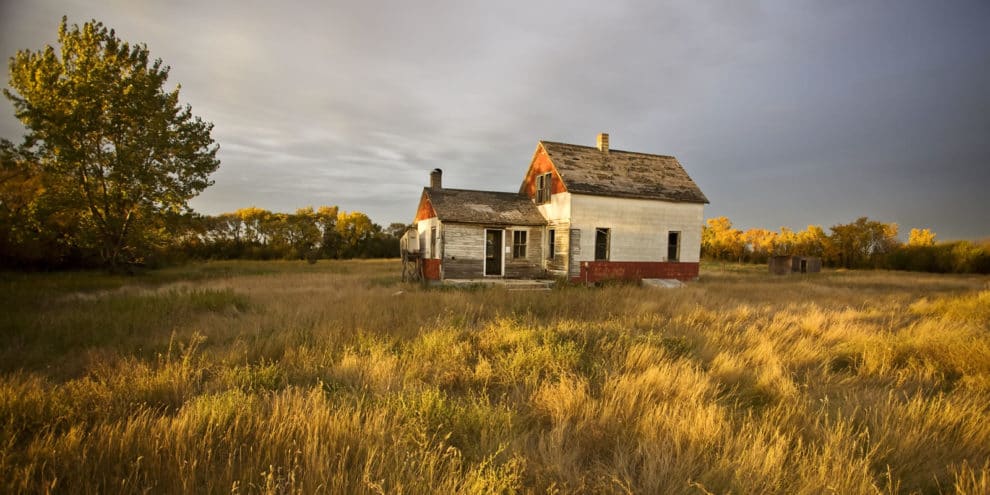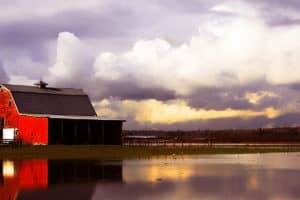Many city-bound Americans see themselves eventually owning an older house in the country. It may be a second home or a retirement spot. It has several large shade trees in the front yard—and a big front porch.
The wood-frame farmhouses that we associate with Norman Rockwell’s America were built from the 1850s through the 1930s. After the War, the style favored one-story brick ranches. Second homes in the country ran toward either log cabins or glassed-up post-and-beamers.
Millions of white, clapboard-sided farmhouses were built across the country in the 75 years before WW II. They best please the eye. They’re well-sited, and their proportions are balanced. Many have porches designed for swing-sitting, but are often used for the year-round “temporary” storage of grills.
Within this group, rural land buyers will find everything from a barely standing wreck to a newly painted pageant hopeful.
In between, you’ll visit: The Project, which you marry till death frees you from the next task, which is never even close to last on the list; The DIY Divorce Fixer-Upper, in which a hostile break-up occurs sooner or later depending on how much work you schedule for the two of you to do together; and, finally, the Goldilocks, which gives you just enough excuse to buy $20,000 worth of tools and only enough projects to hammer your thumb once.
The good news is that if you throw enough money at an old country house, you’ll eventually get something you like. Remodeling budgets on such places tend…to be exceeded.
Many believe that country houses express the personalities of their owners, particularly newcomers. Keep this in mind when choosing exterior colors for stripes and polka dots.
Here are things to look – and look out – for.
Floodplain. Old farmhouses were usually built on flat ground, which was often next to creeks or rivers. Waterfront land locations brought many advantages…until they flooded. If you buy a house in a floodplain, you will be wet.
Scale. With the exception of the Taras and Monticellos, most old farmhouses were built for shorter and thinner occupants than the likes of me. They have low ceilings and small doors, as well as stairways that lead to many banged modern heads. Scale problems cannot be fixed readily or cheaply.
Layout. Original farmhouses lacked closets and indoor bathrooms, both of which have usually been patched in over the years. Farm kitchens are big, but often lack counters and room for cabinets and appliances. Ours has seven doors, which occupy most of the wall space; it’s easier to cook in a galley on a six-foot-long sailboat.
Water in. Springs and wells are typical on-site sources. Buyers need to test these waters for contaminants, then check the systems for integrity and safety. Old plumbing may have lead solder. If the tap water contains grit or color, the cause may be a deteriorated pipe between source and house—a messy and costly repair.
Water out. Farmhouses are usually served by septic systems. The older the system, the less likely it is to meet current local percolation and design standards. Old systems may or may not be grandfathered for new owners. If you add a room, you may be required to add a new septic system.
Some older places use a pipe into a pit…or straight into the creek.
Structure. Farmhouses may or may not be anchored to a foundation; often they’re set on hewn log sills or stones. Redoing foundations is hard and costly. Check the roof and gutters.
Original fireplaces. Safety requires that a chimney flue be lined with heat-resistant tile or an equivalent. Some older flues can be retrofitted; the rest need to be torn out and built from scratch.
Electric and HVAC. Old wiring should be replaced, along with anything less than a 200-amp box. If you’re planning on a duct-based heating and AC system, determine the feasibility of installing ducts before you make an offer. Old plaster walls are expensive to retrofit with concealed ducts and electrical wiring.
Energy efficiency. Wood-frame farmhouses were built without insulation. They are not air-tight; caulking was not available. Attic insulation has usually been added, but walls and floors are less likely to have been upgraded. Old windows and doors are energy-inefficient.
Heating poorly insulated space is expensive. Woodstoves are commonly used to provide cheap heat. The expense of a pick-up truck, chainsaw and back problems are generally not factored into the cost-benefit analysis used to justify wood heat.
On the other hand, lack of tightness improves indoor air quality.
Exterior paint. Assume that you will be painting wood clapboards every seven years. The same for standing-seam metal roofs.
Home inspection. Have one done, before making an offer or as a contingency.
The inspector needs to get up on the roof and into the crawlspace. Use an experienced professional; several trade organizations can recommend inspectors in your area. Remember that a home inspector does not routinely include evaluating farm buildings or the farm’s land and infrastructure.
Bugs and critters. Look for evidence of bad wood and hostile insects. Expect to find mice. Farms are in the country: Be prepared for nocturnal visitors who live here too.
Old farmhouses are quirky, cranky and comfy. Understand what you’re getting into before you make an offer.
One of their virtues above others is this: They’ve been homes for a long time and will readily become yours.
This content may not be used or reproduced in any manner whatsoever, in part or in whole, without written permission of LANDTHINK. Use of this content without permission is a violation of federal copyright law. The articles, posts, comments, opinions and information provided by LANDTHINK are for informational and research purposes only and DOES NOT substitute or coincide with the advice of an attorney, accountant, real estate broker or any other licensed real estate professional. LANDTHINK strongly advises visitors and readers to seek their own professional guidance and advice related to buying, investing in or selling real estate.










Amen, brother. Own a house built in 1876. Been in the family since 1900. Live here by myself, now and a little to much for me.
Reading your article, sent shivers up my spine..lol.
I’m selling, not buying…:-)
We’re in the process of buying an 1895 homestead…has all the shortcomings you mentioned and we’re looking to raise two children (8 & 10) there. With all those shortcomings comes character and the tasks and chores that having a place like this entails. Yes…it will build character…bleed my wallet a bit…but this is a place we can make our own. It has only had two owners since it was built and the last owner raised her family there and has been in it for the past 55 years.
Wish me luck!!